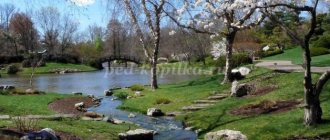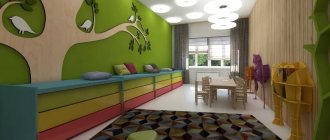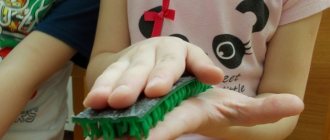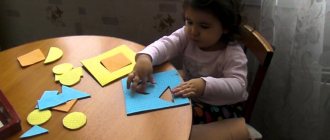Card index of conversations on environmental topics - raising conscious children
Greetings to all my readers! With you, as usual, is the owner of the blog, Tatyana Sukhikh. One reader asked me to share ideas about what issues could be raised in conversations with preschoolers about garbage and cleanliness. So I decided to tell you what topics my file of conversations on environmental topics contains.
Conversation is the most important method of working with children
There are two ways to provide useful information, instill good habits, and give children the skills to do something: talk to kids about pressing topics and set a personal example. If we talk about ecology, then the education of a responsible citizen begins with our personal example and well-constructed conversations filled with emotional examples.
In kindergarten, we “talk” with children all the time, but we don’t limit ourselves to moralizing, but try to make the conversation interesting, instructive and productive. It is clear that garbage is not the only topic of conversation within environmental education. Below I will provide a list of sample topics for all ages.
It is worth saying that the conversation itself is rarely used as an independent method, but it is an obligatory component of any educational moment in a preschool educational institution.
Thus, we distinguish between introductory conversations that organize children to perform one or another type of activity, accompanying conversations during a process or activity, and final or clarifying conversations.
In addition, a distinction is made between cognitive and ethical conversations.
Therefore, the list of topics about ecology from the card index, which I will give below, can be used not only as part of thematic classes on environmental education, a month or week of ecology, but also during walks, when we observe nature, during organizational moments and on special occasions. , if an incident occurs that can be resolved through conversation, for example, a child picked flowers or broke a branch of a tree.
I will also add regarding conversation as the main, in my opinion, method of the educational process, that it is important to understand the power that the human word has. It wounds and heals, lifts you from your knees and kills.
Remember that children absorb literally every statement you make and clearly understand the difference between what you say and how you act in real life.
If you throw cigarette butts and pieces of paper on the sidewalk, there’s no point in moralizing about ethical issues...
List of topics for conversations within environmental education
So, I give a list of topics, and remember that it is suitable for any age, but, naturally, the information content must strictly correspond to the age of the child.
What is clear to the preparatory group will be absolutely incomprehensible to the kids. Next, I will roughly describe what a card from an ecology card index looks like.
And, of course, I’ll give you a tip on a good thematic guide: “Conversations based on pictures “Lessons of Ecology.” Demonstration material. (16 pictures + 8 diagrams).”
Topics of conversation on ecology:
- People are friends of nature;
- You need to be able to feel sorry;
- Amazing all around;
- Forest: love, protect and not be afraid;
- Secrets of plants;
- Birds and animals in winter;
- Pharmacy in the meadow;
- Do animals have houses?
- How can we help nature;
- All living things are under our protection;
- Insects are part of nature;
- Garbage is a disease of the planet;
- Don't pollute nature!
- Kindness must be learned;
- Our home is nature;
- Our helpers are birds;
- Nature in art;
- Fire: friend or foe?
As you noticed, the names of the topics are universal, they are suitable for classes on ecology in the second junior group, and 1st grade will also find something to talk about.
How to design environmental conversation cards
Let’s take the topic: “Don’t pollute nature!” in the older group. We write down the topic on a card, then write down the goals of the conversation:
- Emphasize the problem of human pollution of nature;
- Explain how people pollute the environment: garbage, landfills, water and air pollution;
- Ensure that preschoolers understand the relevance of the problem;
- Together with children, determine ways to solve the problem of environmental pollution.
1. Introductory conversation about the existence of the problem of environmental pollution. Questions for children and expected answers:
— How do people pollute nature? (Garbage, exhaust gases, industrial waste);
— Where does household waste go from apartments and houses? (They take the garbage cars to the landfill);
— What happens to the garbage at the landfill? (Rots, decomposes, emits terrible odors, gathers hordes of rodents, its number is growing);
— How to reduce landfills? (Buy less unnecessary things, sort garbage, recycle paper, glass, compost food waste);
— What can be made from waste paper and glass? (New paper, glass products);
— What other types of waste are there? (Metal, construction, plastic);
- What can be done with them? (Recycle and reuse);
-What do you children throw in the trash can? (Candy wrappers, broken and old toys);
— How to reduce the amount of waste? (Donate unnecessary toys to charity, try to fix broken ones and reuse them, sort other garbage);
— Why do we need waste processing plants? (To recycle and reduce waste).
2. Demonstration of slides about products made from recycled materials.
- What can be made from ordinary garbage? (Paper products, glass, old unnecessary things can be used to make new toys, interior items, crafts and even entire houses);
3. Outdoor game “Who can collect the pieces of paper faster” and “Sorting the garbage.”
4. Drawing on the theme “Garbage and nature.”
5. Closing conversation
- What did we talk about today? (About environmental pollution, waste recycling, recycled products);
- What conclusion can be drawn? (You need to take care of nature, do not litter and try to reduce the amount of waste, give a second life to unnecessary things).
What else should I add?
Using the same principle, you need to think through questions and answers on all topics. Within the framework of the article, I don’t see the point in writing “cheat sheets” on each topic. It’s actually not difficult, the main thing is to know what to talk about with your children. If you really don’t have time, you can buy ready-made cards.
https://www.youtube.com/watch?v=cQfj04uRCLw
Conversations with children of the senior and preparatory groups are carried out as a separate type of educational process and as during other types of activities.
For the younger and middle groups, it is better to talk with children during walks, art classes, etc. And be sure to use life situations to instill in children a reasonable and caring attitude towards the world around them. And let’s not forget to include parents in the work; we consult with them and talk about the same topic.
I hope my tips were useful? If so, share with those who may also find them useful, and please subscribe to the news.
Sincerely, Tatyana Sukhikh! Till tomorrow!
By the way, I recommend reading:
Greetings, dear readers of my blog! I'm with you again...
Hello my good readers! Tatyana Sukhikh is with you today...
Source: https://metodbv.ru/kartoteka-besed-na-ekologicheskuyu-temu/
Structure and timing of the conversation
According to the Federal State Educational Standard, a conversation with children aged 1.5–3 years is based on:
- 1–2 introductory questions from the audience,
- explanations of the material by the teacher,
- conducting a game or dialogue to reinforce the material.
All these types of work take 5–7 minutes and make up three stages of work, respectively:
- introductory (about 1 minute),
- main (about 3 minutes),
- final (up to 3 minutes).
The conversation has a three-part structure
Planning conversations in the first junior group
Conversations with children 1.5–3 years old are held 1–2 times a day, with the exception of situational or individual types that are precedent in nature and periodically repeated (for example, a conversation about polite words, table manners). When drawing up a conversation plan, the teacher is guided by the general theme of educational activities, trying to include different types of conversations in the list.
Table: example of planning conversations in the first junior group for September (fragment)
Author - Kuzmina N.S., teacher at MBDOU d/s No. 60 “Zainka”, Tambov.
| date | Name | Target |
| Topic: “Autumn. Natural phenomena" | ||
| Second week | "About Autumn" | To form a generalized idea of autumn, including knowledge about autumn phenomena in inanimate nature (precipitation, air temperature, soil and water conditions), about the state of plants in autumn and its causes, about the characteristics of animal life. |
| "A miracle is near you" |
| |
| “How to dress in autumn” | Give children knowledge that in the fall it gets cold outside, so you need to dress warmly so as not to get sick. | |
| "Rain" |
| |
| "Leaf Fall" | To form a generalized idea of autumn, the state of plants in autumn and its causes. | |
| Topic: “Vegetable garden. Vegetables" | ||
| Third week | "About people's work in autumn" |
|
| "About vegetables" |
| |
| "Gifts of Autumn" | Talk about vegetables and their health benefits. | |
| "How to behave at the table" |
| |
| "Magic Words" | Formation of politeness in children (thank you for help, say goodbye and hello). | |
Planning allows you to correlate conversation topics with dates
Health Day for children of the 1st junior group
teacher of the highest qualification category Pryakhina Elena Nikolaevna, municipal budgetary preschool educational institution, child development center - kindergarten No. 9 “Forget-Me-not” in the city of Dubna, Moscow region.
Activity:
1. Conversations: “I love vitamins, I want to be healthy,” “Friends of Moidodyr.” 2. Looking at photographs about a healthy lifestyle. 3. Reading fiction: Sergei Mikhalkov “About a girl who ate poorly”, “Walk”. 4. Outdoor game “Do as I do.”
Conversation on the topic: “I love vitamins, I want to be healthy” with children of the first junior group
Target:
Reinforce in children the names of some vegetables, fruits, berries, and food products; expand children’s understanding of how healthy many foods are and how important it is to eat right; continue to improve children’s speech and ability to answer questions; teach children the ability to conduct a dialogue with the teacher. Visual material: dummies of fruits and vegetables.
Progress of the conversation:
The teacher asks the kids:
— Guys, do you like vitamins? What vitamins do you like? (children's answers) Who gives you vitamins? (most likely, the children will name one of the family members, a teacher or a nurse) Where is mom (or others)
) do they buy them? Listen, analyze and summarize the children’s answers.
Next, the teacher informs the children that vitamins are not only sold at the pharmacy in beautiful packaging, but are also found in the foods we eat.
The teacher draws the children’s attention to dummies of fruits and vegetables:
- Look, kids, what do I have? (children's answers) Do you know how many vitamins they contain! Here you go, raise your hands, those kids who love carrots. Well done! Please clap your hands for those little ones who love lemon. Well done! Please, those who love oranges, stomp your feet. Well done!
Oranges help with colds and sore throats! Well, it’s better to eat lemon, even though it is very sour. Eat more oranges, drink delicious carrot juice, and then you will definitely be very slim and tall. There are no healthier products -
Delicious vegetables and fruits.
- But you know guys, vitamins are found not only in vegetables and fruits, but also in other foods. It is very healthy to eat porridge with butter, honey, fish contains many vitamins, you should definitely eat meat. Berries are also rich in vitamins. What berries do you know? (children's answers)
If you want to be healthy, eat right. Eat more vitamins
And don’t know about diseases.
- You see, kids, how many benefits vitamins have! Therefore, eat the vitamins that are bought for you at the pharmacy. But, and most importantly, eat well so as not to get sick, grow healthy and smart!
Conversation on the topic: “Friends of Moidodyr” with children of the 1st junior group
Target:
Continue to develop cultural and hygienic skills in children; expand children’s understanding of how important it is to keep their body, hands, face, etc. clean; continue to teach children to listen carefully to the teacher’s story, to involve children in conversation while looking at the illustrations; teach the ability to conduct a dialogue with the teacher, listen and understand the question asked.
Visual material: illustration “Moidodyr”, screen “Lessons of Moidodyr”, envelope with a letter-poem.
“A letter to all children on one very important matter”
My dear children! I am writing you a letter: I ask you to wash your hands and face more often.
It doesn’t matter what kind of water: Boiled, spring, From a river, or from a well, Or just rain! You must wash yourself in the morning, evening and afternoon - before every meal, before bed and after sleep! Rub with a sponge and washcloth, be patient - it doesn’t matter! And ink and jam Soap and water will wash away.
My dear children! I really, really ask you: Wash more often, wash more often - I can’t stand being dirty. I won’t shake hands with dirty people. I won't go visit them! I wash myself very often. Goodbye! Moidodyr.
(Y. Tuvim)
Reading fiction: Sergei Mikhalkov “About a girl who ate poorly”, “Walk” with children of the 1st junior group
Target:
To develop in children the ability to listen to new poems, to follow the development of the plot in the work; Explain to children the actions of the characters and the consequences of these actions.
Progress of the lesson:
— Kids, today we talked a lot about health, about how important it is to eat well and eat vitamins. And now I want to read you the poem “About a girl who ate poorly.” The teacher shows the children an illustration and reads a poem.
"About a girl who didn't eat well"
Julia doesn't eat well and doesn't listen to anyone. - Eat an egg, Yulechka! - I don’t want to, mommy! - Eat a sandwich with sausage! — Julia covers her mouth. - Soup? - No... - Cutlet? - No... - Yulechka’s lunch is getting cold.
- What’s wrong with you, Yulechka? - Nothing, mommy! - Take a sip, girl, swallow another piece! Have pity on us, Yulechka! - I can’t, mommy! Mom and grandmother are in tears - Julia is melting before our eyes! A children's doctor appeared - Gleb Sergeevich Pugach.
He looks sternly and angrily: “Yulia has no appetite?” I just see that she is certainly not sick! And I’ll tell you, girl: Everyone eats - both animals and birds, From hares to kittens Everyone in the world wants to eat. With a crunch, the Horse chews oats. The yard dog is gnawing on a bone. Sparrows peck at grain, Wherever they can get it, In the morning the Elephant has breakfast - He loves fruit.
Brown Bear licks honey. The Mole is having dinner in the hole. The monkey eats a banana. Boar is looking for acorns. The clever Swift catches a midge. Swiss cheese Loves the Mouse... The doctor, Gleb Sergeevich Pugach, said goodbye to Yulia. And Julia said loudly:
- Feed me, mommy!
— Kids, what was the name of the girl in the poem? Did Julia behave well? What did she do wrong? Who spoke sternly to her? Who did they tell her about? (the teacher listens to the children’s answers, corrects and supplements them, generalizes, draws a conclusion)
- You know, guys, in order to be healthy, you need to not only eat well, but also walk, because while walking we harden ourselves, it’s especially useful to harden ourselves in the summer. Now I’ll read to you about the guys who went for a walk. The teacher reads a poem.
"Walk"
We came to the river to spend Sunday, but we couldn’t find a free place near the river! They sit here and sit there: Sunbathe and eat, Relax as they want, Hundreds of adults and children! We walked along the bank and found a clearing.
But in the sunny clearing, here and there - empty cans And, as if to spite us, even broken glass! We walked along the bank and found a new place. But they sat here before us too; They also drank, they also ate, they lit a fire, they burned paper - they littered and left! Of course, we passed by... - Hey, guys! - Dima shouted.
- This is a great place! Spring water! Wonderful view! Beautiful beach! Unpack your luggage! We swam, sunbathed, lit a fire, played football - had as much fun as we could! They drank kvass, ate canned food, sang choir songs...
We rested and left! And we remained in the clearing By the extinguished fire: Two bottles we broke, Two sodden bagels - In a word, a mountain of garbage! We came to the river to spend Monday, just a clean place
You won't find it near the river!
-Where did the guys go for a walk? What did they see on the river? Do you think it's good to do this? How did the guys relax? What were they doing? Did they do well when they left the river? The teacher listens to the children’s answers, corrects and supplements them, summarizes them, and draws a conclusion:
- Please remember, kids, that when you relax with your parents on the river, keep it clean and tidy. Take care of our nature! Don't pollute it! Our health depends on the purity of nature.




